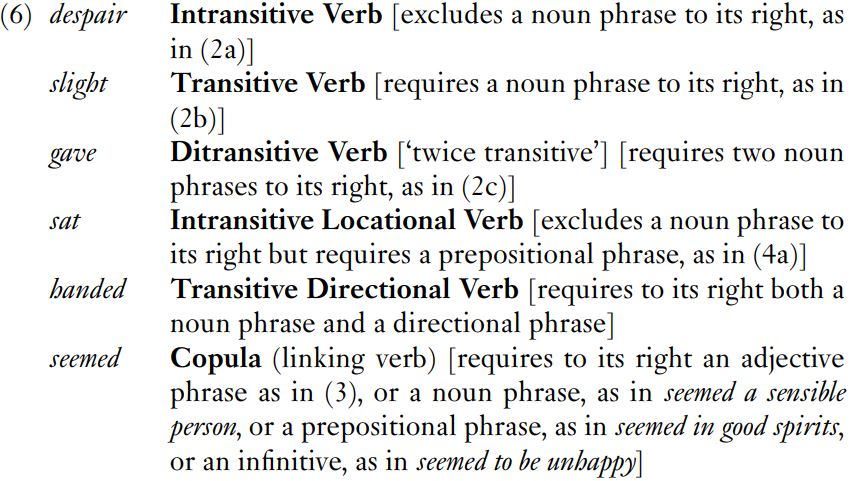

Grammar


Tenses


Present

Present Simple

Present Continuous

Present Perfect

Present Perfect Continuous


Past

Past Simple

Past Continuous

Past Perfect

Past Perfect Continuous


Future

Future Simple

Future Continuous

Future Perfect

Future Perfect Continuous


Parts Of Speech


Nouns

Countable and uncountable nouns

Verbal nouns

Singular and Plural nouns

Proper nouns

Nouns gender

Nouns definition

Concrete nouns

Abstract nouns

Common nouns

Collective nouns

Definition Of Nouns

Animate and Inanimate nouns

Nouns


Verbs

Stative and dynamic verbs

Finite and nonfinite verbs

To be verbs

Transitive and intransitive verbs

Auxiliary verbs

Modal verbs

Regular and irregular verbs

Action verbs

Verbs


Adverbs

Relative adverbs

Interrogative adverbs

Adverbs of time

Adverbs of place

Adverbs of reason

Adverbs of quantity

Adverbs of manner

Adverbs of frequency

Adverbs of affirmation

Adverbs


Adjectives

Quantitative adjective

Proper adjective

Possessive adjective

Numeral adjective

Interrogative adjective

Distributive adjective

Descriptive adjective

Demonstrative adjective


Pronouns

Subject pronoun

Relative pronoun

Reflexive pronoun

Reciprocal pronoun

Possessive pronoun

Personal pronoun

Interrogative pronoun

Indefinite pronoun

Emphatic pronoun

Distributive pronoun

Demonstrative pronoun

Pronouns


Pre Position


Preposition by function

Time preposition

Reason preposition

Possession preposition

Place preposition

Phrases preposition

Origin preposition

Measure preposition

Direction preposition

Contrast preposition

Agent preposition


Preposition by construction

Simple preposition

Phrase preposition

Double preposition

Compound preposition

prepositions


Conjunctions

Subordinating conjunction

Correlative conjunction

Coordinating conjunction

Conjunctive adverbs

conjunctions


Interjections

Express calling interjection

Phrases

Sentences


Grammar Rules

Passive and Active

Preference

Requests and offers

wishes

Be used to

Some and any

Could have done

Describing people

Giving advices

Possession

Comparative and superlative

Giving Reason

Making Suggestions

Apologizing

Forming questions

Since and for

Directions

Obligation

Adverbials

invitation

Articles

Imaginary condition

Zero conditional

First conditional

Second conditional

Third conditional

Reported speech

Demonstratives

Determiners


Linguistics

Phonetics

Phonology

Linguistics fields

Syntax

Morphology

Semantics

pragmatics

History

Writing

Grammar

Phonetics and Phonology

Semiotics


Reading Comprehension

Elementary

Intermediate

Advanced


Teaching Methods

Teaching Strategies

Assessment
Classes of verbs and subcategorization restrictions
المؤلف:
Jim Miller
المصدر:
An Introduction to English Syntax
الجزء والصفحة:
51-5
31-1-2022
1917
Classes of verbs and subcategorization restrictions
Some of these classes of verbs have traditional labels as listed in (6). These labels are convenient for talking about classes of verbs rather than individual verbs.
 To sum up, a given lexical item controls ‘lexical insertion’, the inserting of lexical items into its complements. Another approach that has been advocated more recently is to have no separate set of rules that specify syntactic structure but to have that work carried out by lexical entries. The entry for seem can be thought of as a set of instructions to build a syntactic structure containing a noun phrase, a verb and, for example, an adjective phrase. The entry for hand can be thought of as a set of instructions to build a syntactic structure containing a noun phrase, a verb, a noun phrase and a directional prepositional phrase, and so on for the other types of verb.
To sum up, a given lexical item controls ‘lexical insertion’, the inserting of lexical items into its complements. Another approach that has been advocated more recently is to have no separate set of rules that specify syntactic structure but to have that work carried out by lexical entries. The entry for seem can be thought of as a set of instructions to build a syntactic structure containing a noun phrase, a verb and, for example, an adjective phrase. The entry for hand can be thought of as a set of instructions to build a syntactic structure containing a noun phrase, a verb, a noun phrase and a directional prepositional phrase, and so on for the other types of verb.
As well as controlling the number and general type of complements, lexical verbs control the choice of preposition. For example, blame occurs in the constructions in (7).

Depending on which way the event is presented, blame requires for or on; no other prepositions are possible. Similarly, accuse requires the preposition of, as in Eleanor accused Willoughby of unprincipled behavior.
The constraints that lexical verbs place on number and type of constituents, choice of preposition and choice of case are known as subcategorization. We are dealing with the class or category of verbs, but the different constructions required by different verbs allow us to set up subclasses or subcategories of verb. Hence the term ‘subcategorization’. This discussion has not exhausted the topic of subcategorization; in particular.
 الاكثر قراءة في Syntax
الاكثر قراءة في Syntax
 اخر الاخبار
اخر الاخبار
اخبار العتبة العباسية المقدسة

الآخبار الصحية















 قسم الشؤون الفكرية يصدر كتاباً يوثق تاريخ السدانة في العتبة العباسية المقدسة
قسم الشؤون الفكرية يصدر كتاباً يوثق تاريخ السدانة في العتبة العباسية المقدسة "المهمة".. إصدار قصصي يوثّق القصص الفائزة في مسابقة فتوى الدفاع المقدسة للقصة القصيرة
"المهمة".. إصدار قصصي يوثّق القصص الفائزة في مسابقة فتوى الدفاع المقدسة للقصة القصيرة (نوافذ).. إصدار أدبي يوثق القصص الفائزة في مسابقة الإمام العسكري (عليه السلام)
(نوافذ).. إصدار أدبي يوثق القصص الفائزة في مسابقة الإمام العسكري (عليه السلام)


















